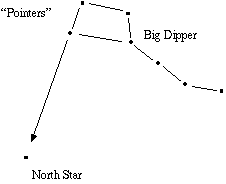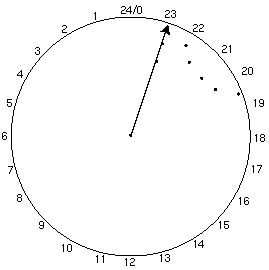
Telling Time by the Big Dipper
Everyone knows that experienced woodsmen and woodswomen can tell time by the stars, but have you ever met anybody that could!? Here's how. This is a project for older students, say 4th through 6th grade, since it involves a little arithmetic and a little imagination. (If you got to this page from the Observing List, remember, some grade schoolers can actually follow the instructions and get the time!!)
Find the Big Dipper and the North Star. The last two stars of the Dipper are the Pointers; a line through them passes close to the North Star.

Imagine that the North Star is the center of the clock, and an hour hand passes up to the Pointer stars. But this is a 24 hour clock, and the hour hand turns backwards! Midnight = Zero hours = twenty-four hours is at the top, 6 hours = 6 AM is on the left, 12 hours = noon is at the bottom, and 18 hours = 6 PM is on the right.

The clock above reads 23 hours. On the night of March 6, you can read the time directly off the clock. If you saw the Big Dipper in the position of the diagram above on the night of March 6, the time would be 23 hours, or 11 PM. Reading the Dipper Clock is the part that requires imagination.
On any other night of the year, take the reading off the "Dipper Clock" and subtract two time the number of months after March 6 from the reading.
Time = Dipper Clock Reading - 2 X (number of months after March 6)
Multiplying by two and subtracting isn't so bad, but how do you figure out how many months your date is after March 6?? That's the hard part. Here are several examples:



This gives you an approximate local solar time, which might be up to an hour or so off the time zone time, depending on where you are in the time zone. To correct to Daylight Saving Time, add one hour to your final result.
Daylight Saving Time = Dipper Clock Reading - 2 X (number of months after March 6) + 1 hour